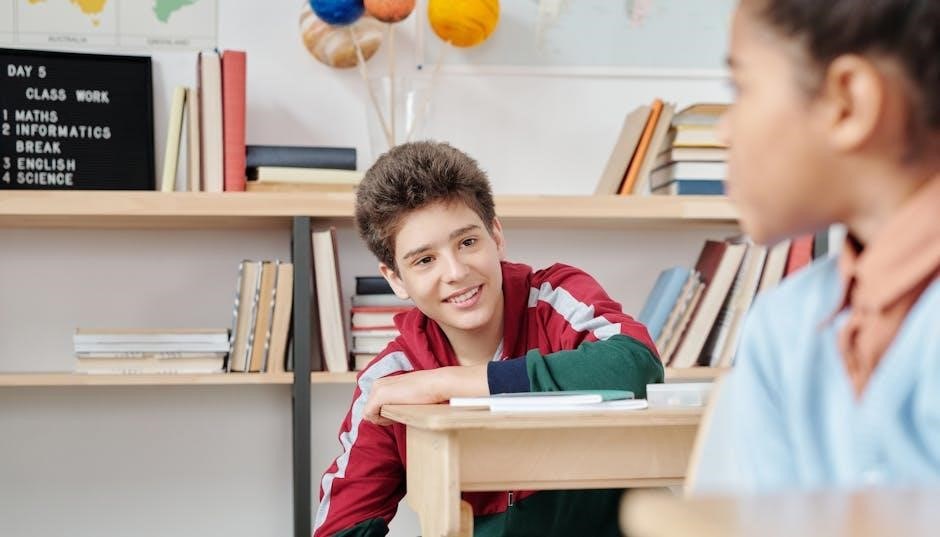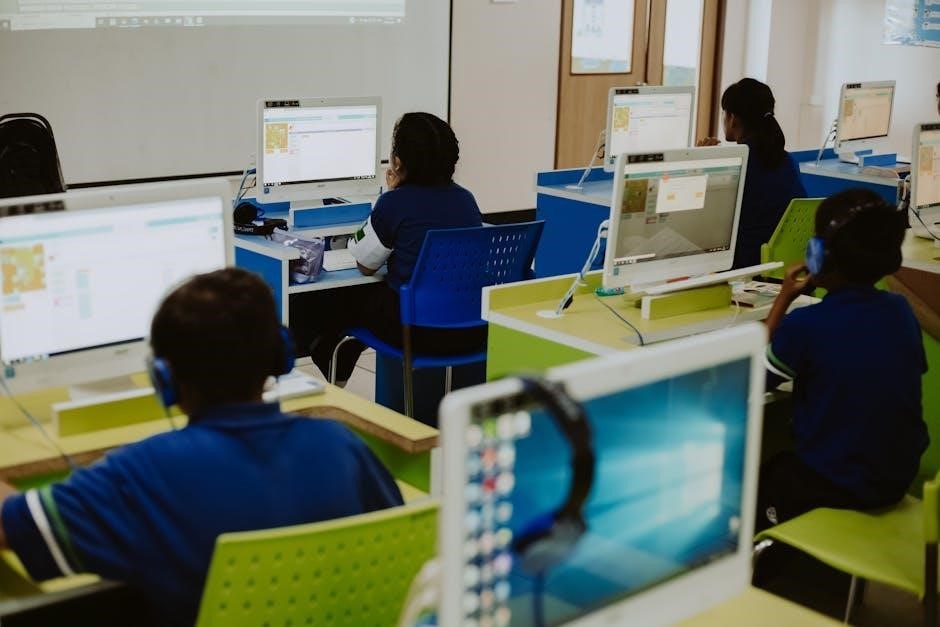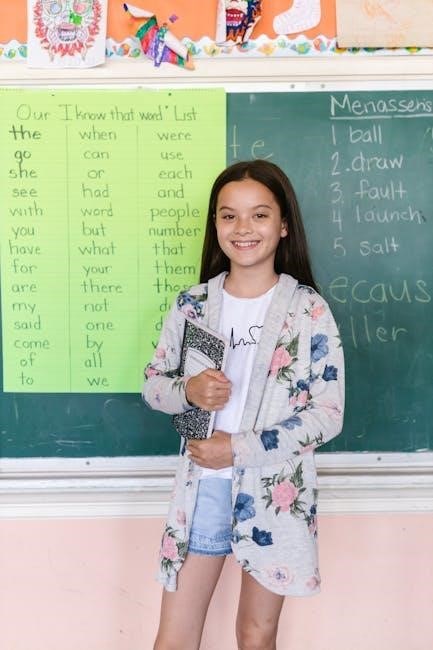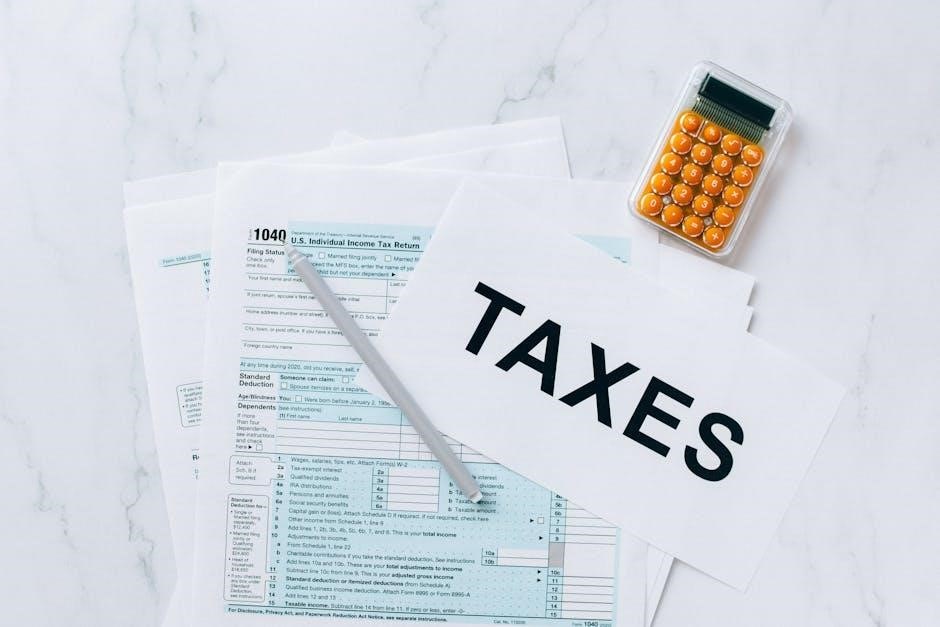
-
By:
- ophelia
- No comment
year 5 maths curriculum pdf
The Year 5 Maths Curriculum aligns with the National Curriculum, focusing on progressive skills development. It emphasizes fluency, reasoning, and problem-solving, building on prior knowledge to ensure a solid foundation for future learning.
1.1 Overview of the National Curriculum Requirements
The National Curriculum for Year 5 Maths is designed to build upon prior learning, ensuring pupils master essential skills in number, algebra, geometry, and data handling. It emphasizes fluency, reasoning, and problem-solving, with a focus on mental and written methods for calculations. The curriculum requires pupils to read, write, and compare numbers up to 1,000,000, understand place value, and interpret negative numbers. It also introduces fractions, decimals, and percentages, alongside basic algebra and data interpretation. The goal is to equip pupils with a strong mathematical foundation for future success.
1;2 Importance of Progressive Learning in Mathematics
Progressive learning in Year 5 Maths ensures that pupils build upon previously acquired skills, deepening their understanding and confidence. This approach allows for a smooth transition from basic concepts to more complex ideas, fostering a robust mathematical foundation. By revisiting and expanding earlier topics, such as place value and fractions, pupils develop fluency and accuracy. This structured progression prepares them for the challenges of Key Stage 2 and future academic success, while also nurturing critical thinking and problem-solving abilities essential for lifelong learning.

Number and Place Value
Focuses on reading, writing, and ordering numbers up to 1,000,000, understanding place value, and interpreting negative numbers. Pupils develop fluency in number operations, enhancing their mathematical confidence.
2.1 Reading, Writing, and Ordering Numbers up to 1,000,000
Pupils learn to read, write, and order numbers up to 1,000,000, understanding their place value. They compare numbers, use <, >, and = signs, and explore numbers in context, including negative values. This builds a strong foundation for more complex mathematical operations and real-world applications, fostering numerical fluency and confidence in handling large numbers.
2.2 Understanding the Value of Each Digit
Pupils develop a deep understanding of the value of each digit within numbers, including units, tens, hundreds, and beyond. This involves identifying and comparing the significance of digits in different places, enhancing their ability to manipulate and compute with precision. Mastery of this concept is essential for solving complex arithmetic problems and applying mathematical reasoning in real-world scenarios, ensuring a robust numerical foundation.
2.3 Counting Forwards and Backwards in Steps of Powers of 10
Pupils learn to count forwards and backwards in steps of powers of 10, such as 10, 100, and 1000, within large numbers up to 1,000,000. This skill reinforces understanding of place value and numerical patterns, enabling accurate navigation through complex number sequences. Mastery of this concept aids in solving arithmetic problems, estimating quantities, and applying mathematical reasoning in practical contexts, ensuring a strong foundation for higher-level maths.
2.4 Interpreting Negative Numbers in Context
Pupils learn to understand and interpret negative numbers in real-world contexts, such as temperature, financial transactions, or positional data. They explore how negative numbers relate to positive counterparts and practice comparing and ordering them. This skill enhances their ability to solve problems involving debt, climate, or coordinates, fostering a deeper understanding of numerical relationships and preparing them for more complex mathematical concepts in subsequent years.

Fractions
The curriculum introduces simplifying fractions, finding equivalents, and converting between mixed numbers and improper fractions. Pupils also learn to multiply fractions by whole numbers, enhancing their numerical understanding.
3.1 Simplifying Fractions and Finding Equivalent Fractions
Pupils learn to simplify fractions by dividing the numerator and denominator by common factors. They also identify equivalent fractions by scaling up or down, ensuring the value remains consistent. For example, 1/2 is equivalent to 2/4 or 3/6. This skill is applied to mixed numbers and improper fractions, enhancing their understanding of fractional relationships. Real-life contexts, such as cooking or measuring, are used to make learning practical and engaging, ensuring a strong grasp of fractional concepts.
3.2 Multiplying Fractions by Whole Numbers
Pupils learn to multiply fractions by whole numbers, understanding that the operation involves repeated addition. For example, 1/5 multiplied by 4 equals 4/5, and 2/3 multiplied by 6 equals 12/3, which simplifies to 4. This concept extends to mixed numbers, such as 1 1/2 multiplied by 3, resulting in 4 1/2. Visual aids like fraction bars and number lines help pupils visualize the process, reinforcing their ability to apply this skill in real-world scenarios, such as cooking or crafting.
3.3 Converting Between Mixed Numbers and Improper Fractions
Pupils learn to convert mixed numbers to improper fractions and vice versa. For example, 1 1/5 becomes 6/5, and 6/5 reverts to 1 1/5. This involves multiplying the whole number by the denominator, adding the numerator, and placing the result over the original denominator. Understanding this relationship aids in simplifying calculations and solving problems involving fractions. Practical examples, such as measuring ingredients or dividing materials, help reinforce this concept, ensuring pupils grasp its real-world applications and mathematical significance.

Decimals and Percentages
This section introduces pupils to decimals and percentages, focusing on adding, subtracting, and rounding decimals. They also learn to understand percentages and their decimal equivalents, applying these skills in real-world contexts.
4.1 Adding, Subtracting, and Rounding Decimals
Pupils learn to perform addition and subtraction with decimals, applying formal written methods. They practice rounding decimals to the nearest whole number or decimal place, using estimation to check reasonableness. Activities include solving problems involving money and measurements, reinforcing real-world applications. This skill progression builds fluency and accuracy, preparing pupils for more complex operations in later stages.
4.2 Understanding Percentages and Their Decimal Equivalents
Pupils explore percentages, learning to convert fractions to percentages and understand their decimal equivalents. They identify percentages in real-world contexts, such as discounts or measurements. Skills include calculating percentages of numbers and comparing percentages to decimals. This foundational understanding prepares pupils for practical applications, such as budgeting and financial literacy, while reinforcing links between fractions, decimals, and percentages.

Geometry
The Year 5 Geometry curriculum focuses on identifying properties of 2D and 3D shapes, measuring angles, and understanding symmetry. These skills enhance spatial awareness and problem-solving abilities.
5.1 Identifying and Naming Properties of 2D and 3D Shapes
In Year 5, pupils explore the properties of 2D and 3D shapes, including the number of sides, angles, and vertices. They learn to identify and name common shapes, such as triangles, quadrilaterals, pentagons, and hexagons for 2D, and cubes, pyramids, and prisms for 3D. The curriculum emphasizes understanding the differences between shapes, recognizing symmetry, and applying this knowledge to solve problems. Practical activities involve sorting, classifying, and describing shapes using precise mathematical vocabulary, preparing pupils for more complex geometric concepts.
5.2 Measuring and Drawing Angles
In Year 5, pupils learn to measure and draw angles accurately using protractors. They identify acute, obtuse, right, and reflex angles, understanding their properties and relationships. Activities involve estimating angles, drawing precise angles to specified degrees, and applying these skills to solve geometric problems. This section builds on earlier concepts, enhancing spatial awareness and mathematical precision, while preparing pupils for more complex geometry in later years.
5.3 Understanding Symmetry
In Year 5, pupils explore symmetry, learning to recognise and create symmetrical patterns and shapes. They study line symmetry, identifying mirror lines and folding shapes to test for symmetry. Activities include designing symmetrically balanced patterns, understanding rotational symmetry, and applying these concepts to real-world objects like flags or architecture. This unit fosters spatial reasoning and creativity, enabling pupils to confidently identify and describe symmetry in various contexts, both abstract and practical.

Algebra
Pupils are introduced to simple algebraic expressions, learning to interpret variables and constants. They explore how to create and evaluate expressions using operations and understand the concept of unknown values. This includes identifying patterns and relationships, forming expressions from word problems, and simplifying them. The focus is on developing an understanding of algebraic notation and its application in solving mathematical problems. Pupils also learn to use inverse operations to find missing values, building foundational skills for more complex algebra in later years.
6.2 Solving Basic Equations
Pupils learn to solve basic equations using inverse operations, starting with simple equations involving addition and subtraction. They progress to equations with multiplication and division, applying their understanding of place value and formal written methods. Pupils also explore equations with missing numbers on either side, developing their ability to reason mathematically. The curriculum emphasizes checking solutions and applying these skills to real-life problems, fostering logical thinking and problem-solving abilities. This foundational skill prepares pupils for more complex algebra in later years.

Data Handling
Pupils develop skills in reading and interpreting tables, charts, and timetables. They learn to extract and present information, understanding how data is used in real-life contexts.
7.1 Reading and Interpreting Tables and Charts
Pupils learn to read and interpret data presented in tables and charts, extracting information to answer questions. They identify patterns, compare data, and draw conclusions. Skills include understanding timetables, interpreting scales, and recognising how data is organised. Pupils also create their own tables and charts, ensuring clarity and accuracy. This strand develops real-world applications, enabling pupils to make informed decisions and present findings effectively, a key skill for future learning and everyday life.
7.2 Understanding Timetables and Schedules
Pupils learn to read and interpret timetables and schedules, understanding time formats and intervals. They extract information to plan routes or calculate durations between events. Skills include identifying start and end times, calculating wait times, and making informed decisions based on the data. This strand links to real-world scenarios, such as public transport or school timetables, preparing pupils for independence and time management. They also learn to create simple schedules, ensuring accuracy and clarity in their representations;

Financial Mathematics
This strand introduces pupils to British coins and notes, teaching budgeting and money management. It covers practical skills like handling finances, saving, and spending wisely in real-life contexts.

8.1 Understanding British Coins and Notes
Pupils learn to identify and understand the value of British coins and notes, including denominations and their equivalent monetary values. They explore practical applications, such as budgeting, saving, and calculating change. This strand emphasizes real-life financial literacy, preparing students to manage money effectively. Activities include recognizing coins like 1p, 2p, 5p, 10p, 20p, 50p, £1, and £2, and notes like £5, £10, £20, and £50. Understanding the concept of total money management is central to this curriculum area.
8.2 Basic Budgeting and Money Management
Pupils learn essential skills in budgeting and managing money, including calculating totals, making change, and comparing prices. They explore real-life scenarios, such as saving for goals and understanding the difference between needs and wants. This strand aims to develop financial literacy, enabling students to make informed decisions about money. Activities include creating simple budgets and understanding the importance of responsible spending, preparing them for independence in financial matters.

Assessment and Progression
Assessment in Year 5 Maths monitors progress, identifies areas for support, and informs teaching strategies. It ensures pupils meet end-of-year expectations and prepares them for Key Stage 2 SATs.
9.1 End of Year Expectations
By the end of Year 5, pupils are expected to demonstrate proficiency in key mathematical skills. They should read, write, and compare numbers up to 1,000,000, understanding place value and interpreting negative numbers. Pupils should confidently use fractions, decimals, and percentages, applying these to solve problems. Fluency in multiplication and division, along with understanding geometric properties, is essential. Pupils are expected to reason mathematically and apply skills to real-world contexts, ensuring readiness for the challenges of Key Stage 2 and future academic success.
9.2 Preparation for Key Stage 2 SATs
Year 5 maths curriculum ensures pupils are well-prepared for Key Stage 2 SATs. The programme focuses on consolidating skills in number, fractions, decimals, and geometry. Pupils engage in regular practice with past papers and problem-solving activities to build confidence. Emphasis is placed on mental calculations and formal written methods for accuracy. Teachers use curriculum maps and progression documents to track readiness. The curriculum aligns with National Curriculum objectives, ensuring pupils master essential concepts and apply them effectively in timed assessments, fostering resilience and mathematical fluency for success in SATs and beyond.